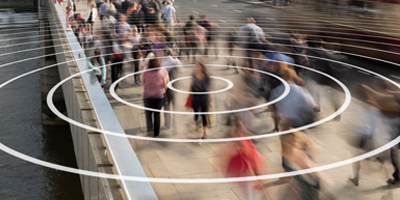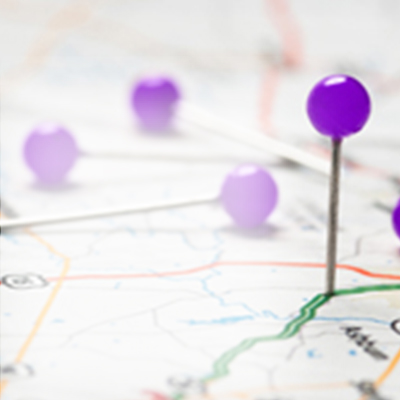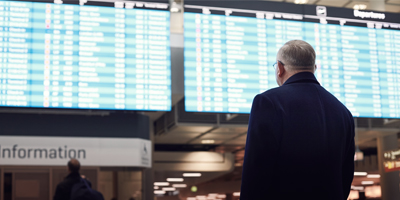Technology 101
If this is your first time shopping for a location management system, the acronyms might seem like alphabet soup.
You may be comfortable using GPS in your car, but wonder how you can use the same technology to help locate a person. Here is a run-down of common tracking technologies and information about emerging trends.
What you should know
-
No system is 100% accurate. Some devices don't work well inside buildings.
-
Some systems can only locate a person to a general vicinity. Weather may even be a factor.
-
A location management service is not the same as a 24-hour companion.
-
There may be a time delay in receiving alerts based on the monthly plan purchased.
-
Before choosing a device, find out if the network the device depends upon is reliable where the person with Alzheimer's lives and in the areas he or she is likely to travel.
Global Positioning System (GPS)
 Many location management services rely on GPS technology. GPS depends on satellites to provide positioning and navigation information. The device communicates with satellites and figures out the distance to each and then uses this information to deduce its own location. In order for GPS to work, there must be a clear line of sight between the device and the satellites.
Many location management services rely on GPS technology. GPS depends on satellites to provide positioning and navigation information. The device communicates with satellites and figures out the distance to each and then uses this information to deduce its own location. In order for GPS to work, there must be a clear line of sight between the device and the satellites.
Advantages: GPS is not dependent on the availability of a network and can provide very precise, worldwide outdoor positioning information at any time of day.
Limitations: Natural barriers, such as mountains, thick foliage or clouds, and artificial obstructions, such as large buildings and dense communities, can hinder satellite signals. For this reason, GPS tracking inside buildings is seldom possible. Also, GPS tracking in large cities is not always reliable.
Network Assisted GPS (A-GPS)
A-GPS technology works in conjunction with GPS by using cell towers to triangulate locations.
Advantages: A-GPS can provide indoor positioning information with greater accuracy and is usually faster than unassisted GPS.
Limitations: A drawback to A-GPS is the availability and reach of the cellular network it gets its boost from. If you travel out of the network's reach, your device won't be able to pick up the signals.
Radio Frequency Identification (RFID)
RFID works through the transmission of radio waves between a transponder, an antenna and a receiver. The RFID chip transmits a signal to the receiver through the antenna and provides data on a person's location.
Advantages: Some RFID chips require no batteries (they use power from the initial radio signal to transmit their response) and so offer long-term reliability.
Limitations: Key limitations of RFID are the need for multiple pieces of equipment and a limited signal range. Additionally, most systems using RFID technology offer the service through local law enforcement so it is necessary to determine whether your community supports a RFID location system.
Online applications
Some location management services will have an online application allowing families to locate on demand through an online mapping tool wherever they have access to the internet. Some applications also provide the option of setting up zones and will alert the family if the person leaves the zone.
Advantages: Online applications allow families to proactively manage the location of the person living with Alzheimer's. Families can use the application to look up the person's location at any time. Applications that provide the ability to set zones can send alerts when the person leaves the zone, helping the family manage the person's location from afar.
Limitations: For alerts to be sent when the person leaves the zone, the device and the application must communicate at regular intervals. The communication between the device and the application typically takes place on a cellular network. The communication can be impeded if the network coverage is not adequate, impacting the application's ability to send a zone alert. Additionally, the time interval between communications is determined by the monthly service plan. It is important for families to understand what that time interval is when they make choices about zones. For example, if the device communicates every 30 minutes with the application, a zone alert could take from 1 to 30 minutes to be received by the family.
Technology trends
Technology moves quickly, and that's why the Alzheimer's Association is keeping up to date on emerging technologies. We are making sure we know about the latest location management devices and networks so that we can provide families the information and education needed to pick the device that best meets their safety needs.
Questions and answers
Choosing a location management system and device is like choosing a mobile phone. You select a device that has the look and features you want, but you also have to consider the service provider that comes along with that phone. Similarly, if you find a location device you like, the technology that powers it needs to also meet your needs.
To hone in on the best device and service for your needs, ask yourself these questions:
What stage of Alzheimer’s is the person in now? Are they still active and driving?
A person who is in the early stage of the disease may be fine with a car-based solution or pocket device while driving or going about his or her daily routine. A person who has more significant memory problems may need a wrist-worn device that is more difficult to lose or remove. See information about driving and Alzheimer's in our Dementia and Driving section.
Where does the person live: in an urban, rural or suburban setting?
Some technology (Global Positioning System (GPS) in particular) can be less accurate in dense areas, and so may not be a good fit for a person who lives in a city with many high buildings or next to a large body of water. Incorrect or inaccurate location information can occur in urban areas as a result of interference created by buildings and other infrastructure between the device and the satellites. Rural areas may have limited network coverage and people who live in these areas need to make sure the service they buy provides reliable coverage.
Where do you want to able to locate someone: indoors, outdoors or both?
While GPS does not always provide accurate indoor location information, it can be accurate to within a few feet outdoors. Network Assisted GPS (A-GPS) can provide indoor location information with greater accuracy than unassisted GPS. What might be helpful for both indoor and outdoor monitoring is the availability of zones or geofences. Some applications allow you to set up zones, or pre-determined boundaries around the home or community of the person with Alzheimer’s. Some systems will send you alerts when the person has entered or left pre-set zones.
How frequently will you want to locate someone? Any time of day or night? Only when they leave home or a pre-set zone? Only when you suspect they have wandered or are lost?
If you want to locate someone "on-demand", or whenever you want, look for a system that provides location verification on a regular basis. By communicating frequently with the device, the system verifies and updates the person’s location at regular intervals allowing you to look up the location at any given time. If you are interested in the ability to monitor a person’s activities over a period of time, you might want to consider a system that can provide constant tracking. Constant tracking will show a person’s location as they move about.
Wandering and getting lost is common among people with dementia and can happen during any stage of the disease.
If you are confident in the person with Alzheimer’s ability to be independent, but would like alerts when he or she has entered or left a pre-set zone, make sure the device or system has a zone or geofence feature and is able to deliver alerts through multiple methods (to your cell phone, email, etc.).
Should you consider zone alerts and how do they work?
For location management systems to send an alert when a person exits a zone, the application must communicate with the device at regular intervals. The time interval between communication points is determined by the location management service. For example, if the device communicates every 30 minutes with the application, a zone alert could take from 1 to 30 minutes to be received by the family. It is important for families to review the time interval to determine if it meets their level of comfort in terms of the length of time it may take to receive an alert. Additionally, the communication between the device and the application typically takes place on a cellular network. If the network coverage is poor, the ability of the device to communicate with the application may be impacted and an alert may not go out.
How comfortable are you with computers and the Internet? Do you have access to a computer and a reliable Internet connection?
If you have a dial-up connection to the internet, or are not comfortable using a web application, you may be more comfortable with an emergency-only solution or one with monitoring assistance. Some solutions have a monitoring center that can help locate the person on a map for you and in an emergency, launch a community support network, and/or facilitate communication with law enforcement to help reunite the family with a person with Alzheimer’s.
What is your budget for a tracking solution? Have you identified all your needs?
Tracking devices and solutions can vary in price and usually include a one-time purchase fee for the device and/or application, an activation fee and a monthly plan. Identify what your needs are before you select a plan. For example, if you will need a lot of “locates” or “finds” or have a need to continuously track a person over time, you will need a bigger data plan and your cost may l be higher.
The cost of your monthly plan is impacted by the location verification frequency. If the plan calls for communication at more frequent intervals, the monthly cost may be higher. If you are interested in an emergency-only system that provides help from the call center during a wandering incident, you may not need a large data plan. Make sure you check the cancellation policy, or see if the solution you choose has the option to change as the person's safety needs change.
How do you want to receive alerts?
If you are in front of a computer all day, you may wish to receive alerts via email. If you are on the go and receive text messages, you may want have alerts sent via text message to your mobile phone. Some solutions also have a 24/7 monitoring center that can help with location assistance or activate a community network during an emergency.
There are solutions that do not require you to check your computer for information. Some plans include zone alerts, which notify family members when the person with Alzheimer’s travels in and out of zones, the person’s device has a low battery or lost connection. Most of these solutions allow you to choose who should receive the alerts.
There is no system that is real time. There may be a delay in the alerts received based on the monthly plan purchased. Often a plan is designed to help balance battery life, costs and to accommodate the time intervals of the location verification.
Related Content

Connect with others in our online community.
Join ALZConnected
Learn how Alzheimer’s disease affects the brain.
Take the Brain Tour




